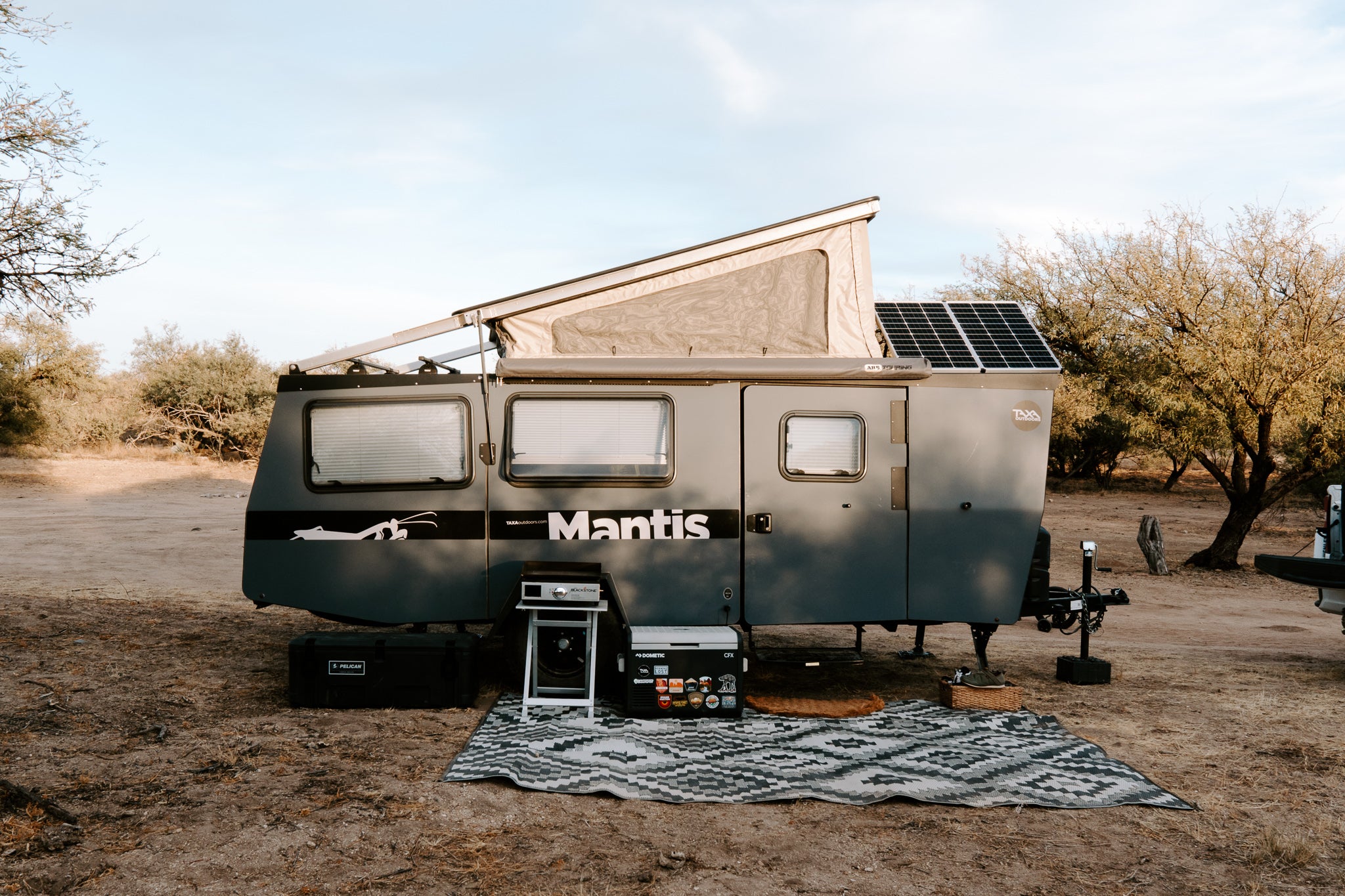Most people who camp off-grid seem to have solar panels installed on their campers or RVs. It allows them to go further and stay longer in the great outdoors. So, is solar worth it for your travel trailer? The cost has fallen drastically over the past few years while the cost of fossil fuels has increased. Upgrading to solar seems like the smart alternative, but it can still be pricey. Let’s take a good look at the details, so you can decide what’s right for you.
Types of solar panels for campers
The main difference between solar panel types is the shape of the silicon crystals in the cells. Monocrystalline photovoltaic cells have a homogenous crystal structure, polycrystalline cells have multiple crystal formations, and thin film uses an amorphous layer of photovoltaic material. Below are the benefits, relative costs, efficiencies, and disadvantages of each type.
- Monocrystalline - are cut from single slices of silicon and can deliver optimal output for nearly 40 years. These cells are the most expensive choice, but have the highest heat tolerance and efficiency.
- Polycrystalline - are made from melted silicon fragments with a decent lifespan of 25 to 30 years. They offer moderate heat tolerance and cost somewhat less than monocrystalline panels.
- Thin film - comprised of a variety of materials wrapped around an absorber layer, either made of amorphous silicon crystals, cadmium, or a copper composite. This option has the lowest cost, lifespan, and efficiency levels. The advantages of thin film is the literal flexibility and ease during installation and its sustainable manufacturing process.
With this information in mind, it seems that monocrystalline solar panels are the clear choice for travel trailers, boondocking, and dispersed camping. Not only will you get better heat resistance, but also more efficient panels with longer lifespans. You could also opt for a variety of choices by using one type on your camper roof and another on a standalone generator.
What do solar panels do on a camper?
Solar panels produce a direct current (DC) from sunlight via photovoltaic (PV) cells. This direct current can only be plugged into a designated battery charging port on a camper pre-wired for solar. The DC energy is run through a solar charge controller and can power most camper appliances.
The term “pre-wired for solar” can be somewhat misleading for first-time RV owners. A camper pre-wired for solar can charge its direct current system from a solar panel. It does not mean you can use the 120V active current (AC) power outlets or run the refrigerator, microwave, or air conditioner when off-grid. For that, you need an inverter, a unit that turns DC energy into AC to be used by more sensitive appliances. With an inverter, you can run all of your devices off-grid; however, you first have to find out your energy requirements and compatible inverter wattage.
How many solar panels do I need on my camper?
Theoretically, you can run your entire camper off of solar power. However, many factors ultimately decide the number of panels you’d need to go completely off-grid. For example, the amount of sunlight, geographical location, and daily energy requirements. Follow these steps to figure out how many solar panels to install on your trailer or RV:
- Find out how many kWh a day your camper uses - to do this, use this online calculator to tally up the number of watts for each device in relation to the hours of use per day. For instance, an 800-watt microwave run for thirty minutes each day would require 0.4 kWh.
- Compare this to the output of energy produced per panel - solar panel output ranges from 0.17 kWh to 0.35 kWh. Considering most regions get roughly 7 hours of peak sunlight per day, this equates to a daily median of around 2.0 kWh. Meaning, an RV using a 3,000-watt air conditioner for six hours and a microwave for 15 minutes needs roughly ten solar panels to cover the energy costs.
- Review your camping style - you might not need to become completely self-sufficient using solar in your mobile habitat. Unless you plan to spend weeks remote camping, most RV travelers can get by with simply covering a portion of energy used during their trips with solar power.
Can you run your camper AC on solar panels?
One of the most common uses for a camper using solar with an inverter is powering the air conditioning. Yes, you can run your camper air conditioning on just solar power, but you need to find out how many solar panels you’ll need to install. The typical solar panel produces between 1.5kWh and 2.4kWh per day, and the standard RV air conditioning unit consumes around 30kWh per day. This means you would need about 15 to 20 solar panels to run your camper air conditioner – which might not be feasible on most camper trailers or RVs.
Also, you would need a high-watt inverter to convert the DC power from the solar panels into an active current (AC). The same goes for other 120V active current appliances like microwaves and refrigerators. On average, RV air conditioning units run at around 3,000 watts; meaning, an inverter with a capacity of 3,500 to 4,000 watts is ideal. Review the specifications of your camper’s air conditioning system before buying an inverter.
Benefits of RV solar panels
No matter if you’re going dispersed camping or traveling to a beachside RV park, supplementing camper power with solar panels is convenient and can save you money in the long run. Here are some of the benefits of using a solar generator or powering your RV with solar panels:
Drawbacks of RV solar panels
The main drawbacks of solar panels for campers are the reliability and cost of the systems. Some solar power systems can run upwards of $3,000 for more reliable units. On top of this, solar panels might have a limited output depending on the location of the camper and amount of direct sunlight or weather conditions.
Common upgrades for camper solar systems
A standard upgrade for camper solar systems is an inverter. Adding an inverter is usually a simple upgrade that you can DIY or hire an electrician. If you decide to do this yourself, spend some time learning about fuses and the correct wire sizes to ensure a safe installation. The most significant advantage of choosing this option is creating a set-it-and-forget-it solar solution – once you mount the panels on the roof, your work is done.
Another upgrade to consider is a standalone generator with a built-in inverter. The best advantage of a solar generator is that you need zero technical skills to use it. In addition to this, you have more flexibility in choosing a location for sunlight than with rooftop-mounted panels. Generators are great for overlanding trips and you can also charge them using a standard campground electrical hookup.
Get a pre-wired adventure vehicle for your travels
Maybe you’re looking to go further than you ever have before, or simply cover your bases in case your campsite won’t have an electrical hookup. In both cases, finding a camper pre-wired for solar makes setting up your solar system much easier. TAXA adventure vehicles are wired for compatibility with popular solar brands like Renogy, Goal Zero, Zamp, and Dokio. Call a TAXA guide today and find out which solar-ready travel trailer is right for you!


